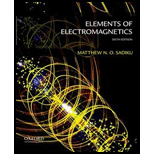
(a)
Find whether the given field
(a)
Answer to Problem 38P
The
Explanation of Solution
Calculation:
Given field is,
Generally, the vector is a magnetostatic field if its dot product is zero and the vector is an electrostatic field if its cross product is zero. That is,
For magnetostatic field,
For electrostatic field,
Substitute
Substitute
Simplify the above equation.
Therefore, for the field
Conclusion:
Thus, the vector
(b)
Find whether the given field
(b)
Answer to Problem 38P
The vector
Explanation of Solution
Calculation:
Given field is,
Substitute
Substitute
Simplify the above equation.
Therefore, for the field
Conclusion:
Thus, the vector
(c)
Find whether the given field
(c)
Answer to Problem 38P
The vector
Explanation of Solution
Calculation:
Given field is,
Substitute
Simplify the above equation.
Substitute
Simplify the above equation.
Therefore, for the field
Conclusion:
Thus, the vector
Want to see more full solutions like this?
Chapter 7 Solutions
Elements of Electromagnetics (The Oxford Series in Electrical and Computer Engineering)
 Elements Of ElectromagneticsMechanical EngineeringISBN:9780190698614Author:Sadiku, Matthew N. O.Publisher:Oxford University Press
Elements Of ElectromagneticsMechanical EngineeringISBN:9780190698614Author:Sadiku, Matthew N. O.Publisher:Oxford University Press Mechanics of Materials (10th Edition)Mechanical EngineeringISBN:9780134319650Author:Russell C. HibbelerPublisher:PEARSON
Mechanics of Materials (10th Edition)Mechanical EngineeringISBN:9780134319650Author:Russell C. HibbelerPublisher:PEARSON Thermodynamics: An Engineering ApproachMechanical EngineeringISBN:9781259822674Author:Yunus A. Cengel Dr., Michael A. BolesPublisher:McGraw-Hill Education
Thermodynamics: An Engineering ApproachMechanical EngineeringISBN:9781259822674Author:Yunus A. Cengel Dr., Michael A. BolesPublisher:McGraw-Hill Education Control Systems EngineeringMechanical EngineeringISBN:9781118170519Author:Norman S. NisePublisher:WILEY
Control Systems EngineeringMechanical EngineeringISBN:9781118170519Author:Norman S. NisePublisher:WILEY Mechanics of Materials (MindTap Course List)Mechanical EngineeringISBN:9781337093347Author:Barry J. Goodno, James M. GerePublisher:Cengage Learning
Mechanics of Materials (MindTap Course List)Mechanical EngineeringISBN:9781337093347Author:Barry J. Goodno, James M. GerePublisher:Cengage Learning Engineering Mechanics: StaticsMechanical EngineeringISBN:9781118807330Author:James L. Meriam, L. G. Kraige, J. N. BoltonPublisher:WILEY
Engineering Mechanics: StaticsMechanical EngineeringISBN:9781118807330Author:James L. Meriam, L. G. Kraige, J. N. BoltonPublisher:WILEY





